
Saccharum is a genus of tall perennial plants of the broomsedge tribe within the grass family.

The Celastraceae are a family of 98 genera and 1,350 species of herbs, vines, shrubs and small trees, belonging to the order Celastrales. The great majority of the genera are tropical, with only Celastrus, Euonymus and Maytenus widespread in temperate climates, and Parnassia (bog-stars) found in alpine and arctic climates.

Myoporum is a genus of flowering plants in the figwort family, Scrophulariaceae. There are 30 species in the genus, eighteen of which are endemic to Australia although others are endemic to Pacific Islands, including New Zealand, and one is endemic to two Indian Ocean islands. They are shrubs or small trees with leaves that are arranged alternately and have white, occasionally pink flowers and a fruit that is a drupe.

Pithecellobium is a genus of flowering plants in the family Fabaceae. It includes approximately 23 species from the tropical Americas, ranging from Mexico to Peru and northern Brazil, including the Caribbean Islands and Florida.

Stryphnodendron is a genus of flowering plant in the legume family, Fabaceae. It includes 28 species of trees and suffrutices native to the tropical Americas, ranging from Nicaragua to Bolivia, Paraguay, and southern Brazil. Typical habitats include tropical rain forest and riparian forest, seasonally dry forest, cerrado, and caatinga. It belongs to the mimosoid clade of the subfamily Caesalpinioideae.
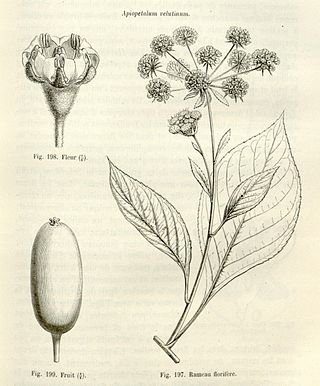
Apiopetalum velutinum is a species of plant in the family Apiaceae. It is endemic to New Caledonia.
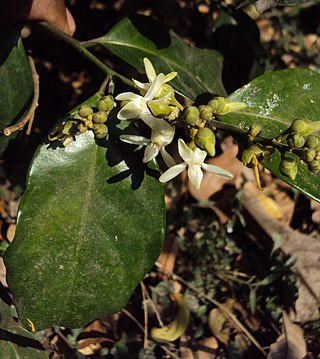
Xanthophyllum is a genus of about 109 species of trees and shrubs, of the plant family Polygalaceae;. The generic name is from the Greek meaning "yellow leaf", referring to how the leaves are often yellow when dry. In Borneo it is known as minyak berok in Malay or nyalin in the Iban language.
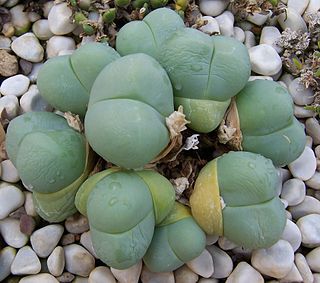
Gibbaeum is a genus of about 21 species of small succulent plants of the family Aizoaceae, indigenous to the Little Karoo region of South Africa. The name "Gibbaeum" comes from the Latin gibbosus (hunchback)

Acer velutinum is a species of tree in the Sapindaceae family. It is referred to by the common names velvet maple or Persian maple, and is native to Azerbaijan, Georgia and northern Iran. It grows in the moist Caspian Hyrcanian mixed forests as wells as parts of Eastern Georgia.

Calopogonium is a genus of flowering plants in the legume family, Fabaceae. It includes eight species, which range through the tropical Americas from Mexico through Central America, the Caribbean, and northern South America to northeastern Argentina. It belongs to the subfamily Faboideae.

Hymenolobium is a genus of flowering plants in the legume family, Fabaceae. It includes 14 species of trees native to Central America and northern South America, ranging from Honduras to Bolivia and southeastern Brazil. Most species are native to Brazil, the Guianas, and Venezuela, with one extending into Peru, another into Ecuador, and one native to Central America. Trees are typically very tall and emergent in tropical humid lowland rain forest.
Australopyrum is a genus of plants in the grass family, native to Australia, New Zealand, and New Guinea.

Ribes velutinum is a species of currant known by the common name desert gooseberry.
Erythranthe hymenophylla, synonym Mimulus hymenophyllus, is a species of flowering plant in the lopseed family known by the common names thinsepal monkeyflower and membrane-leaf monkeyflower. It is native to Hells Canyon on the border between Oregon and Idaho in the United States. It has also been reported from Montana.
Xanthophyllum velutinum is a tree in the family Polygalaceae. The specific epithet velutinum is from the Latin meaning "velvety", referring to the twig and leaf undersides.

Myoporum velutinum is a plant in the figwort family, Scrophulariaceae and is endemic to a small area near Esperance in Western Australia. It has similar flowers and fruits and grows in similar environments to Myoporum tetrandrum but differs from it and all other members of the genus by having hairs on the outer edge of the petals.

Stenopetalum is a genus in the Brassicaceae family which is endemic to Australia. It was first described by Robert Brown in 1821.
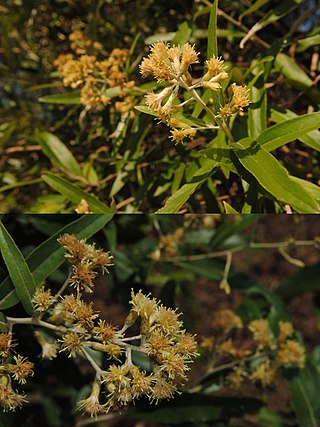
Moquiniastrum is a genus of flowering plants belonging to the family Asteraceae.

Phalaenopsis difformis, also known as the dark brown Phalaenopsis, is a species of epiphytic orchid native to Assam, Borneo, China South-Central, China Southeast, East Himalaya, Laos, Malaya, Myanmar, Bangladesh, Nepal, Sumatera, Thailand, Vietnam and West Himalaya.
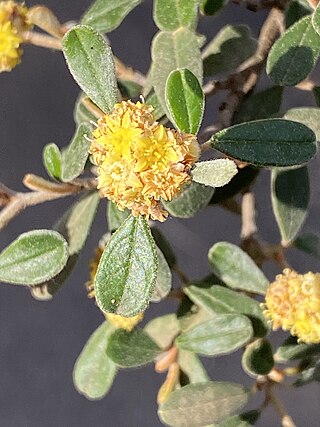
Spyridium obovatum is a species of flowering plant in the family Rhamnaceae and is endemic to Tasmania. It is an upright shrub that typically grows to a height of 0.9–2.5 m and has egg-shaped leaves, the narrower end towards the base, and about 13 mm (0.51 in) long. Small, compact heads of flowers are arranged on the ends of branchlets, the sepals either cream-coloured or yellow, depending on the variety.
















